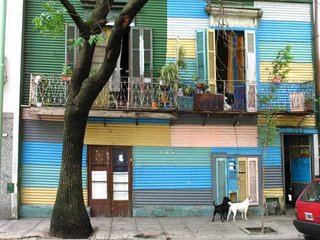Sand, Surf, Diapers
 As Emily mentioned in her last post, there’s not a whole lot to do in the summer community of Mar de Ajo. In fact, we were initially concerned that we might grow bored during our weeklong sojourn there. The local movie theatre was showing Hollywood pap that we’d already caved in and watched in Buenos Aires, The Bingo Palace wasn’t ready to begin hosting bingo until January, and the miles of pizza parlors and alfajor shops weren’t quite the draw that they were for the kids in our host family. As a result, we spent an awful lot of time at the beach. And, as we probably should have guessed, we enjoyed ourselves immensely. In addition to copious swimming and lots of reading (I have to finish all 900 pages of Bleak House before January 3rd, because I’m not lugging it through Patagonia), there were entertaining sites to behold on nearly every stretch of sand. In fact, one of the nice things about plopping down in the same spot day after day is that we got to know the cast of characters on the beach pretty well––from a distance, of course. Sadly, we were too shy to take pictures, but I thought I would highlight some of our favorite Mar de Ajo beach regulars.
As Emily mentioned in her last post, there’s not a whole lot to do in the summer community of Mar de Ajo. In fact, we were initially concerned that we might grow bored during our weeklong sojourn there. The local movie theatre was showing Hollywood pap that we’d already caved in and watched in Buenos Aires, The Bingo Palace wasn’t ready to begin hosting bingo until January, and the miles of pizza parlors and alfajor shops weren’t quite the draw that they were for the kids in our host family. As a result, we spent an awful lot of time at the beach. And, as we probably should have guessed, we enjoyed ourselves immensely. In addition to copious swimming and lots of reading (I have to finish all 900 pages of Bleak House before January 3rd, because I’m not lugging it through Patagonia), there were entertaining sites to behold on nearly every stretch of sand. In fact, one of the nice things about plopping down in the same spot day after day is that we got to know the cast of characters on the beach pretty well––from a distance, of course. Sadly, we were too shy to take pictures, but I thought I would highlight some of our favorite Mar de Ajo beach regulars.The Odd Couple. This middle-aged couple was fascinating because they did not appear to enjoy the beach, yet returned to it day after day. Terrified of the sun, they usually brought an enormous bed sheet with them, which they huddled beneath for solar protection. For a million reasons, including the strong wind at Mar de Ajo, this did not ever seem to work very well. This alone might not have been enough to make the list, but they manage to squeeze on here because the man wore a baseball cap to go swimming. Third place.
The Brazilians. We don’t actually know that this family was Brazilian (we never heard Portuguese, but we never heard Castellano either). However, my Spanish teacher once informed our class that no self-respecting Argentine male would ever wear bikini briefs to the beach, hence our suspicions. The Brazilians were fond of playing a paddleball style game on the beach each morning, wearing approximately three square inches of spandex between them. Good stuff, yes, but the highlight definitely came when the wife had the husband lay down in her lap, and proceeded to snip every single one of his goatee hairs with a tiny pair of scissors. Freshly shaved, the man proceeded to sprint into the surf and collapse the instant a wave hit him. Second place.
Diaper Man. We had observed Diaper Man from a distance during our first few days at Mar de Ajo, but it wasn’t until he set up shop immediately beside us that we got to really observe him in his glory. Diaper man was an incredibly tanned, grey-haired, middle-aged man who wore bright white shorts and sneakers to the beach. It was only while playing soccer with his son that he underwent his transformation. Tucking the legs of his white shorts into the edges of his underwear, so that it resembled a billowing diaper, he would proceed to dart around the beach, heading and high-kicking the ball with a complete lack of talent. To this day, we’re still not certain what purpose the diaper served, but we think that it might have ever so slightly helped to improve his range of motion. His teenage son was incredibly unbothered by his father’s appearance. In fact, one of Diaper Man’s best attributes was his total unwillingness to run after the ball. Following a horrendous kick, in which he caused the ball to jet into the surf, Diaper Man would furiously signal his son to retrieve the ball, which the boy did with unfailing loyalty. Diaper Man, Grand Prize Winner. -NSH









